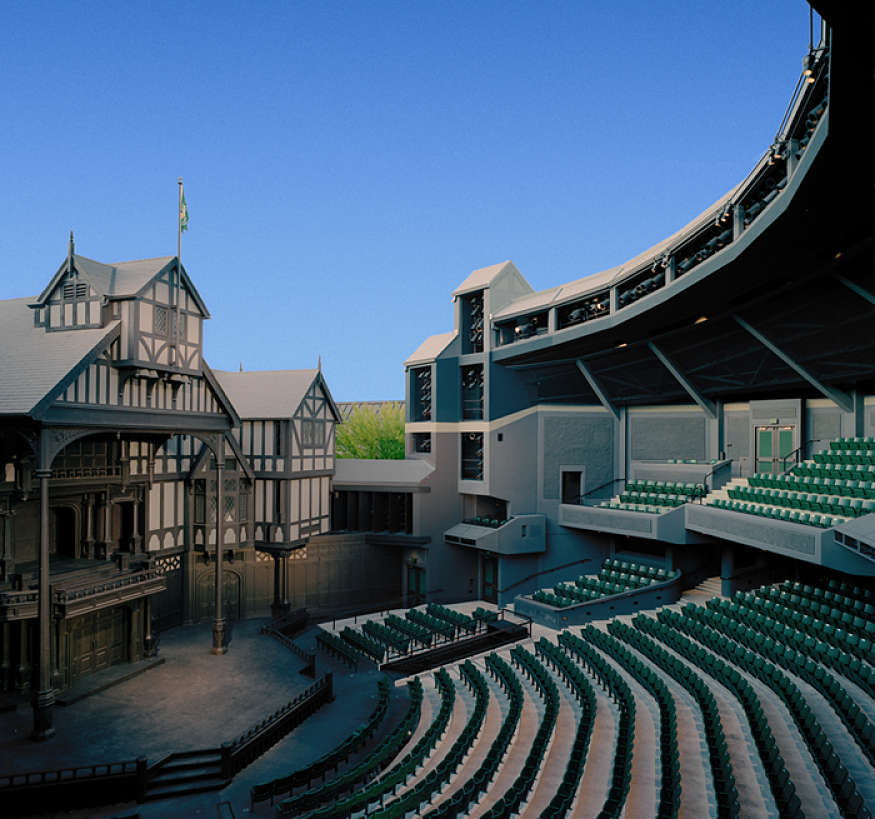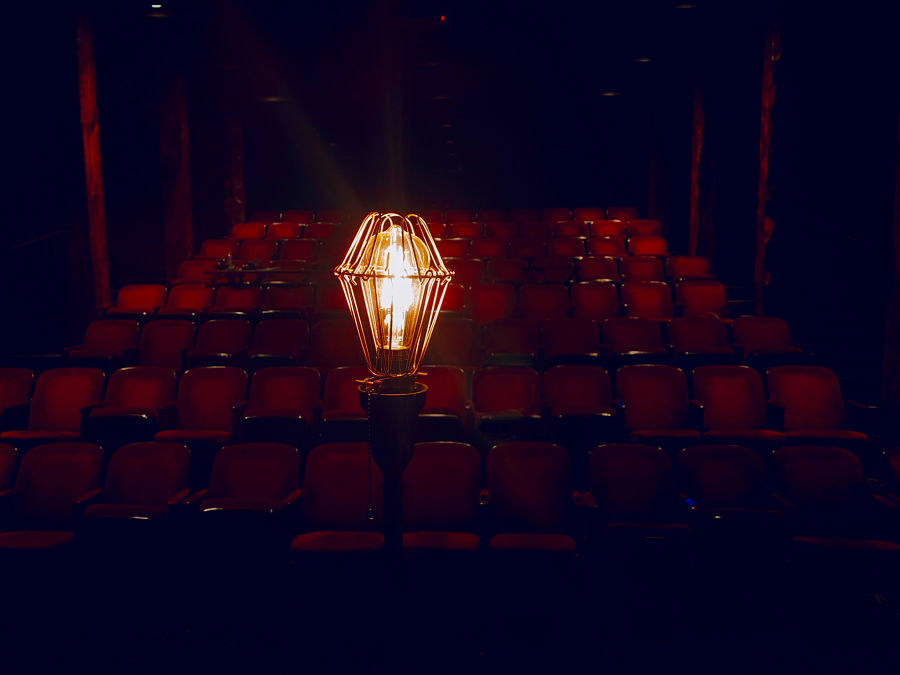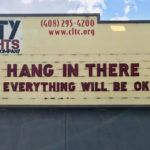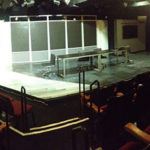“It’s like a Greek play,” Chay Yew told me. I chuckled with shock at the matter-of-fact severity of the analogy. The paralyzing global spread of COVID-19 has been compared to zombie movies, the Great Depression, World War II, and the so-called “Spanish” flu of 1918 (which in fact originated in Kansas). But the Olympus-high stakes of Sophocles or Euripides? Sure. It sounded grimly apt for a pandemic whose body count climbs toward an uncharted peak as I write, and whose effects on our social and economic, not to mention our artistic and spiritual lives, will be felt for at least a generation.
Yew, outgoing artistic director of Chicago’s Victory Gardens Theater, is among a group of artistic directors, producers, and playwrights I’ve been speaking to since the metastasizing coronavirus outbreak forced theatres from Broadway on down to join most public businesses in the U.S. in closing their doors until further notice. It has been alternately harrowing and heartening to talk with the makers and movers of an art form we love, which has given them careers and me a subject, at the very moment that art form faces an existential crisis the likes of which could barely have been imagined even a month ago, and is still hard for many of us get our heads around. Shanta Thake, senior director of artistic programs at New York’s Public Theater, put the dilemma succinctly: “If we’re not gathering, who are we?” Choreographer Bill T. Jones, who leads both an eponymous dance company and New York Live Arts, put it more personally: “Sweat and breath in real time—is that a dimension I have to give up as an artist? That shakes me to my core.” And Robert Falls, artistic director of Chicago’s Goodman Theatre, compared the crisis to “an arrow that has been shot in the heart of artists who are all about gathering and sharing in a room.”
Indeed. It was Barry Edelstein who, later on the same day I spoke to Yew, stopped me in my tracks again. The artistic director of San Diego’s Old Globe, Edelstein was describing a season that had been “firing on all cylinders,” but is now gutted by the coronavirus shutdown; he’s had to furlough many workers, and is looking at projections for the future in “60-day chunks.” At the time we spoke, he and his team were still weighing a July start date; since then Oregon Shakespeare Festival and California Shakespeare Theater canceled their summer seasons and laid off large percentages of their staff, as the prospect of social distancing measures stretches ahead months, not weeks. Edelstein mentioned that a member of his theatre’s board had died the previous day (not from the coronavirus, he hastened to add). That board member, he said, will not have a funeral.
I know it’s a medical reality—there is a refrigerator truck piled with plastic-wrapped bodies a mere 15 minutes from where I write this, in Queens, the fever-hot center of New York City’s coronavirus epicenter. But it took Edelstein’s comment to make me feel the depth of this crisis. When our most sacred rituals are forsaken, when we cannot even gather to mourn or celebrate life and death, what hope can there be for theatre? Has this ancient, stubbornly durable live art finally met a tragedy it can’t dramatize its way out of?
Or, as playwright Morgan Gould put it in a provocative post in a series of “Dispatches From Quarantine” for American Theatre online, “Will there even be theatre six months from now?”
The potential scale of the damage to theatre institutions and artists in the U.S. is no easier to anticipate than is the unprecedented wider shock of this unfolding crisis to our general society and economy. So far the bleeding has been stanched at a few key exit wounds, though it’s unclear how long the bandages will hold. On Broadway, unions for performers and stagehands reached a deal with producers to be paid through Easter, 30 days from the district’s shutdown on Thursday, March 12, with a special provision reached even for employees who had shows lined up but hadn’t yet begun rehearsals or previews.
Meanwhile major nonprofit theatres around the country, which mostly shuttered that same weekend (the ides of March, no less) and announced cancellations of the remainder of their spring seasons, made similar provisions for contract workers hired for scotched shows, mostly per union agreement. On the matter of staff, the nation’s theatres took diverging paths: Many announced temporary layoffs, or furloughs, of many or most employees, while others committed to paying their staff for months, many at reduced salaries but with full benefits.
Countless other small theatres, though, do not have the resources to do much more than go dark and hope for leniency from landlords, leaving thousands of freelance artists out of booked jobs—and health-qualifying work weeks—for the foreseeable future. While freelance theatre artists, along with all gig workers, will get a piece of the $2 trillion relief package recently passed by Congress and signed by the president, and while small theatres can conceivably apply for no-interest small business loans now on offer, the financial forecast for this non-negligible segment of the American economy is bleak at best.
Uncertainty is the slow-acting poison here. Just how long will social distancing and “sheltering in place” be required, or at least advised, to reduce the spread of the disease? At presstime, the advice of medical professionals, reluctantly acceded to by the president, was that these guidelines should stay in place through April and even May. Beyond that, no one knows what’s in store, and theatres have been keeping options open. Joseph Haj, artistic director of Minneapolis’s Guthrie Theater, said that he and his board are “theorizing multiple scenarios: What if we can’t start till fall? What if we can’t start until the holidays? Okay, what if it’s not until the beginning of the next calendar year? Each scenario looks very different.”
At Repertory Theatre of St. Louis, artistic director Hana S. Sharif says that while she’s operating on the assumption that “this is going to be a couple of months, not 18 months, we have daily conversations that feel like playing craps. There’s so much unknown. It’s a frightening time, but I haven’t allowed myself to be frightened by what’s ahead—there’s so much work to do. I’m feeling the energy of, we’ve got to find ways to move forward.” Still, she spoke for many when she added, “It all feels really fragile. Any little string could make the whole thing completely unravel.”
Indeed, even when an “all clear” signal comes from on high (and provided we can trust it), how eager will theatregoers be to return in large numbers to tight spaces and literally breathe the same air—the “magical substance,” as playwright Sarah Ruhl put it in a recent speech, “which makes theatre different from books or films” but “is what we fear right now”? Said Pam MacKinnon, artistic director of American Conservatory Theatre in San Francisco, “We think of ACT as an essential gathering place. But is ‘gathering’ going to be a bad word in a couple of years? Is it going to inspire people or make them nervous? After 9/11 in New York, there was a yearning for face-to-face. But this is a contagious and virulent virus.”
Broadway producer Kevin McCollum, who had to postpone the openings of Six and Mrs. Doubtfire, and who calls this interim “a time of recalibration and reflection,” believes that theatre audiences are “pretty fearless. It’s not easy to see a show. You have to show up a certain time. It’s not a disposable item—you have to work really hard.” But while he’s hopeful that audiences will eventually return, he is in no rush. “We need a safe environment to bring everyone back together. We can’t be cavalier about the science just because we want to sell a few more theatre tickets.”
Social aversion aside, the willingness or ability of theatregoers to spend money at pre-COVID levels will be a big question mark. But the toll is not just economic, as author and teacher Todd London noted. “The people who work in the theatre—we are collective, social beings, unlike poets or painters or novelists,” he said. “I care about the physical well-being but also the spiritual well-being of artists, who are dealing with huge disappointment and productus interruptus, and the pain of that.”
As much as the people I spoke to expressed disappointment about projects that had been canceled or postponed, most were bracing themselves for further losses down the road.
“There are going to be theatres that won’t survive the crisis,” said playwright Lynn Nottage, whose opera Intimate Apparel, based on her play, was in previews at Lincoln Center Theater (it has been moved to the fall). “By and large those will be smaller theatres, producing adventurous work, with younger writers and directors. There’s a generation that will be affected in ways we don’t know.”
Producer Mara Isaacs, who worked for years as a producing director at Princeton, N.J.’s McCarter Theatre Center before branching out as an independent producer with Octopus Theatricals, echoed this concern. Though she’s one of the key movers behind the Broadway hit Hadestown, she mostly produces indie theatre, seeding projects by artists who survive on grants and tours, for whom “there’s no safety net. Theatres have buildings, they have boards, insurance. But all these people who make shows—that is a gig economy, there is no salary or benefits.” Isaacs has been organizing a group of like-minded producers to “create some visibility and ask, what happens if this sector of the field goes away?”
There’s another painful wrinkle to this turn of events. In the past few years, many of the nation’s institutional theatres have undergone a generational turnover, with an increasingly diverse crop of new artistic directors taking the helm of legacy institutions: Sharif at St. Louis Rep, Haj at the Guthrie, MacKinnon at ACT, Jacob Padrón at Long Wharf Theatre, Stephanie Ybarra at Baltimore Center Stage, Maria Manuela Goyanes at Woolly Mammoth, Nataki Garrett at Oregon Shakespeare Festival, and Eric Ting at Cal Shakes, among others. Many have faced the usual ups and downs of leadership transitions; some, like Padrón at Long Wharf, have also been charged with rebuilding their theatre’s dented profile and imperiled finances.
“It was an intensive operation to stabilize and right-size the organization,” Padrón said of his first tumultuous year. “Now to be hit with this crisis—it tests our capacity, our bandwidth. We were already in a vulnerable position, and it’s exacerbated by this.” He echoed a paradox voiced by many I spoke to: “We’re trying to respond as quickly as possible, but we’re also trying to be really thoughtful.”
Reversing the order but echoing that divided impulse, the Goodman’s Falls said, “I feel we need to sort of sit with it, live with it, not ignore it, particularly if you’re going to make art, but for all of us in the theatre. The other side, though, is that we have to move forward.”
Institutional leaders aren’t the only ones who feel the contradictory pressures of this hurry-up-and-wait moment. Said playwright/translator Caridad Svich, “We need to really do deep listening and fast footwork at the same time. How do these things work together? They kind of don’t.”

Theatre has survived worse, even in its cradle. The plague of Athens killed some 25 percent of its population in 430 B.C.E., and inspired the Theban plague in Sophocles’s Oedipus Rex. Shakespeare’s career was famously interrupted by the Black Plague, during which time, as Edelstein pointed out, the Bard and his colleagues did three things: “They made plans for what they were going to do when theatres reopened. They toured the provinces, sold props, costumes, bundled plays and sold them—that’s how the First Folio got made. And they went to the King and said, ‘Help.’”
Another generation-defining scourge is within the living memory of many still working today, one that inspired its own canon of essential American plays even as it decimated a generation. Said playwright and performer Taylor Mac, who has lent talent and time to TrickleUp NYC, an online project designed to aid out-of-work indie theatremakers, “I’m a child of the AIDS epidemic. People are like, ‘We’ve never lived through anything like this,’ and I tell them, ‘You must be straight. I could tell you personally 100 people who died of AIDS.’ This is not the worst thing that’s happened if you’re queer. Let’s keep things in perspective.”
“This is the second plague in my lifetime,” concurred playwright Paula Vogel, whose play How I Learned to Drive was scheduled for a belated Broadway run to open April 22. “When I was caretaking my brother Carl, who died of HIV, we didn’t know how it was spread. So as a family we came together and realized that we’d grown complacent in the belief that science will save us. I do think that COVID is going to make us much more aware of community and of the necessity to be kind. For when science fails us, and it will, kindness never will.”
For now, though, such kindness must be conveyed through virtual channels only, and in a brutal irony the most loving act now is to self-isolate. While some theatremakers plan on using this unplanned downtime to catch up on their writing—Young Jean Lee quipped, “Playwrights are the least interesting people to talk to about this, because we’re just going to stockpile scripts and catch up on our commissions”—others are finding it hard to concentrate. Said Nottage, who initially found that “the pause in activity was welcome,” the space that “has been cleared for rumination has been filled with other anxieties” (not to mention childcare).
Still, many I spoke to have been following some or all three elements of the Shakespeare sabbatical outlined by Edelstein: planning for an eventual return, finding alternative outlets in the meantime, and making the case for government support. All three mandates are spurring their share of creativity and soul-searching, though the first—plans for reopening—is the most contingent on the progress of the virus, and on the drastically altered landscape it may leave behind.
As for alternative avenues in the meantime, these have not been in short supply. Several theatres, from ACT to Syracuse Stage to South Coast Rep to Theater Wit, were able to capture shows in performance before they had to close them, and with Actors’ Equity they crafted contracts that allowed these shows to be broadcast online to ticketholders in return for two weeks of actors’ pay. For a hot minute it looked like this crisis might force a long-overdue conversation about why American theatres don’t have the equivalent of Britain’s National Theatre Live, and whether it’s time to put such an arrangement in place in the States. That moment may have passed: While every theatre worth its salt is offering some online goodies, if only to maintain their connection and brand awareness with patrons, the fact that social distancing prevents any new productions from being staged, let alone filmed and broadcast, means a rain check on this long-overdue conversation.
The talking points are in place for when it resumes, though. Many theatremakers and union reps I spoke to about the possibility of more widely available filmed performances ranged in their attitude from cautious to skeptical. Kathryn M. Lipuma, executive director of Writers Theatre, spoke for many when she said, “Film can’t do what we do, and film people do what they do better than we can. The collective spirit, being in a shared experience in a room with people you don’t know—how do you recreate that in a new medium?” But at OSF, where a digital channel is widening as the theatre’s stage offerings have shrunk this season, a.d. Nataki Garrett said, “I don’t think one supplants the other; I think they dance together. People thought that having baseball on television would ruin the game, but their crowds grew exponentially. When you watch something online it increases your appetite to see something like it. I will use Beyonce’s Homecoming as an example: Every time I watch that, I wish I were there. It whets your appetite but it doesn’t feed you fully.”
Not all such alternative programming need be online. At Seattle Repertory Theatre, near the heart of an early COVID-19 beachhead in the U.S., artistic director Braden Abraham said he’s wondered, “How can the theatre serve the community during this time? Can our space be used for a blood drive?” Likewise, Washington, D.C.’s Woolly Mammoth Theatre Company has previously partnered with Whitman Walker Health, which serves marginalized communities, and Woolly artistic director Maria Goyanes said she recently reached out to them to say, “Woolly’s not doing anything right now, and we’ve got a big lobby. If coronavirus tests become available, could you use it as a testing center?”
In Play at Home, a heartening initiative from D.C.’s Woolly Mammoth, NYC’s Public Theater, St. Louis Rep, Baltimore Center Stage, Long Wharf Theatre, and Berkeley Repertory Theatre, playwrights were offered “micro-com- missions” to create new works anyone can read and stage at home. Said Center Stage’s Ybarra, “It’s going analog with our imaginations again, and it gives people a chance to participate in our art form, not just witness it.” It’s also “putting just a little bit of money back into the theatre ecology” at a particularly lean time.
As we head into the most daunting economic downturn of our lifetime, the third move in the Shakespearean plague playbook—seeking government support—has increasing salience.
“Artists are as important as highways and hospitals to the ordering of a sane society,” said Bill T. Jones. “In this society, artists are so expendable, existing only to be cast aside. We shouldn’t do that in this moment. I hope that this COVID interlude gives us the moral courage, the spine, to change that.”
The nation’s bipartisan $2 trillion relief package contains some $300 million for arts-related organizations—considerably less than the $4 billion lobbied for by cultural advocates, including the Performing Arts Alliance and Theatre Communications Group, but given the current administration’s previous proposals to eliminate all funding for the NEA and NEH, it’s a start. And the push to center theatre as essential is about more than federal lobbying. Said Mara Isaacs, “Too often we’re invisible to the larger world. Somehow we have to be engaging that larger world in every conversation, not just our little insular bubble. Considering the contribution we make to the economy, it’s just ridiculous—and in fact, now we can actually see what happens when you shut down all the shows.”
While many folks I spoke to rhapsodized hopefully about the ways a sudden and prolonged withdrawal of live performance would make it seem that much more precious when it returns, many fixated on the ways this collapse will reorder the landscape—wrenchingly, tectonically, but in some ways for the better.
Said Chay Yew, “We’ve always complained about how the American theatre doesn’t work. I for one find the blank slate exciting. We either repeat what we did before or we don’t. The structure will have to come down.”
Joe Haj conceded that if the crisis “ends in six weeks, we may be much like we were before. But if not, or there’s another spike in the virus, we may need to rethink our model entirely. There’s a huge role for leadership. We need to be able to dream ourselves forward.”
Playwright Dominique Morisseau, whose play Confederates was to go up at Oregon Shakes in April and at New York’s Signature Theatre in May, made a generational argument. Young people, she reasoned, are “going to be the ones to start gathering again first when this is over, and we have already missed an opportunity to make them feel at home, to make them feel like their ideas and their presence matter, to prioritize them like we never have before. They save every dying industry and every industry in peril. For too many of them, theatre is seen as an elitist sport and a hobby. If instead we say, This is how society is gathered, it’s a way to build our community—if we make it a sanctuary, they will come.”

Death has been on my mind a lot lately—not chiefly the prospect of my own mortality or that of my loved ones and neighbors, though I’d be lying if I said that hadn’t crossed my mind. Instead I’ve been preoccupied with the matter of what, if anything, can be said to last beyond an ending. I’m a fairly religious person, but I’ve never been entirely sold, or at least not especially clear, on the notion of an afterlife for the spirit, let alone a bodily resurrection.
But this crisis has made me think about not only our brief, fragile individual lives, but of the health of institutions and the life cycles of professions. What does it mean to leave a legacy? We often focus hopefully on the legacy part, less so on the leaving. Clearly, the longer this crisis stretches on, the more theatres and careers will effectively die. But the practice of gathering in a room to share stories with strangers? I have little doubt that, after some indeterminate period of readjustment, theatre will be reborn and live on. “Theatre is real, and people are going to need real,” as Kevin McCollum put it. Is that assurance enough to hold onto—that this beloved art will persist in some form, even when some indeterminate number of artists and venues we cherish today will not? Is it comforting, in other words, to believe that even after the body that once carried a spirit falters and fades, the spirit may somehow be reincarnated in new bodies yet to be born?
Rob Melrose, the new artistic director at the Alley Theatre in Houston, where the economy has been further buffeted by the oil price war between Russia and Iran, told me about an actor who had lost multiple bookings to the coronavirus shutdown. Riding home from one such canceled gig in a New York City cab, she shared her plight with the driver.
“He happened to be a Greek cab driver, and he pulled out his cell phone and showed her a picture of a Greek theatre,” Melrose said. “He told her, ‘This is how long your art form has been around. It will survive.’”
There’s comfort in that anecdote if you love theatre in the abstract. But if you love certain specific theatres and artists working now—and if you consider the long, bloody arc of history between ancient Greece and today—there is much that’s dreadful about it too.
The best and worst we can say is that we don’t know what’s coming next. “Plagues in ancient narratives are usually the beginning, not the end of the story,” Joel Christensen, a classical studies professor at Brandeis, wrote recently. And in another of AT’s “Dispatches From Quarantine,” playwright Idris Goodwin threw down a gauntlet of sorts. “This ain’t the intermission,” he wrote. “It’s the show…This is the moment where everything changes. We are in the inciting incident.”
Allison Considine contributed reporting for this story.









